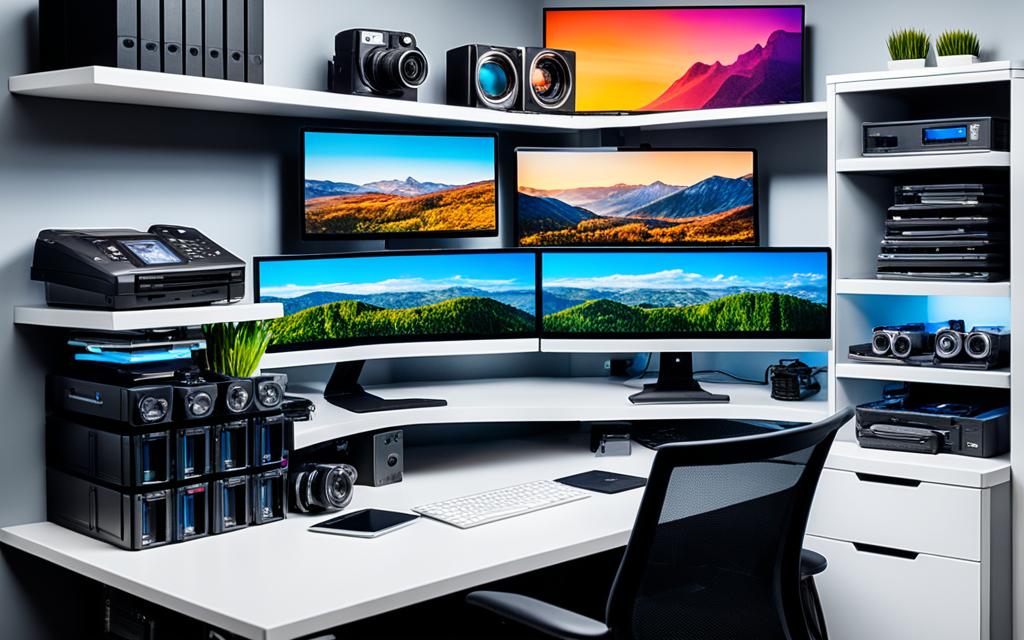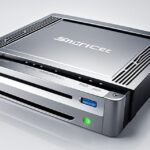Table of Contents
Choosing the right computer for photo storage and editing is very important. It can greatly affect how you manage and work on your photos. As more demanding photo editing software emerges, it’s vital to pick a computer that is reliable and fast. You should think about the computer’s processor speed, how much memory it has, and the kinds of storage it offers. This will help make sure your photo editing runs smoothly. In this guide, we will compare different computer specs. This will help both pros and hobbyists choose the best computer for editing photos, whether they’re working at different locations or in their studio. Have a look at this detailed resource1 for more tips on selecting a computer.
Key Takeaways
- Choosing the right specifications is vital for efficient photo editing.
- Consider future-proofing your equipment as software demands increase.
- Processors ideally should range from quad-core to six-core configurations for enhanced multitasking capabilities.
- For basic photo editing, a minimum of 8GB RAM is recommended, while 16GB is better for handling higher-resolution images.
- SSDs offer faster access speeds compared to HDDs, although they come at a higher cost.
- Evaluating both Mac and PC platforms can reveal unique strengths in various editing tasks.
- Workstation computers, such as those from HP and Lenovo, present viable options for professional-grade performance in photo and video editing2.
Understanding the Importance of a Robust Computer for Photographers
A strong computer is essential for photographers, not just a nice-to-have. It greatly affects how efficiently a photographer can work. With software like Adobe Lightroom and Photoshop, computers need to handle heavy tasks smoothly.
Impact on Workflow Efficiency
Having a fast and reliable computer helps photographers work on high-quality photos with ease. For smooth editing3, at least 8GB of RAM is needed. A powerful photo editing laptop should have an Intel i7 or AMD Ryzen 7 processor, 16GB RAM, a Full HD screen, and a minimum of 500GB SSD storage3. Bigger screens help with more precise edits, often making desktops the better choice for bigger projects4. Also, dedicated graphics cards boost processing power, avoiding slowdowns with heavy software use.
Future-Proofing Your Equipment
Buying a powerful computer now reduces the need for frequent upgrades later. Desktops offer more value and can be easily customized as tech advances3. Laptops, while portable, can overheat and slow down over time, especially with heavy editing use3. Choosing a desktop for long-term use is smart. It’s wise to pick one that supports 4K and extra storage for future needs3. This way, your setup will stay effective for new software down the road.
Key Specifications to Consider
Picking the right computer for editing photos means knowing important specs that impact performance. You’ll need to look at the processor power, RAM, and type of storage to really improve your editing flow. Here are the main components to consider.
Processor Power: What You Need
The processor is key for your system’s editing capability. Aim for at least an Intel Core i5 or AMD Ryzen 5. For the best performance, especially with Photoshop and Lightroom, go for higher-end models like the Intel Core i9 13900K or Intel Core i5 13600K. These are great because they handle tasks smoothly and quickly5. Newer processors bring improvements that boost the speed and efficiency for heavy-duty editing5.
Memory Requirements: The Role of RAM
RAM is also crucial for your computer. For basic editing, 16GB of RAM should do. But for bigger projects, like panorama stitches or huge files, you might need 32GB or more5. If you’re using AMD processors, getting faster RAM, like 3600MHz DDR4, can make things run smoother5.
Storage Options: HDD vs SSD
Understanding HDD and SSD storage is vital. HDDs are great for keeping lots of images because they offer a lot of space and are cheaper per GB. For storing software and ongoing projects, NVME SSDs are better because they let you access files quicker56. A good idea is to have both types, like a 256GB SSD for speed and a 1TB HDD for storage space6.
| Specification | Recommended for Basic Editing | Recommended for Advanced Editing |
|---|---|---|
| Processor | Intel Core i5 / AMD Ryzen 5 | Intel Core i9 13900K / Intel Core i5 13600K |
| RAM | 16GB | 32GB or more |
| Storage | 256GB SSD + 1TB HDD | 512GB SSD + 2TB HDD or more |
Knowing about these specs will help you choose wisely for your photo editing needs56.
Best Computer for Photo Storage
When it comes to the best computer for photo storage, several options stand out for their exceptional performance and capabilities.
High-Performance Desktop Options
The Apple Mac Studio tops the list as a premium choice among high-performance desktops. It offers up to 192GB of unified memory, great for complex tasks and creative projects7.
The HP Envy 34 is known for its spectacular 5K display. It blends design with power, making it suitable for demanding tasks7. The Dell XPS Desktop is another top pick. It’s good for photo editing and gaming, showing how creative professionals can find a versatile tool7.
Versatile Laptops for Editing on the Go
The Apple MacBook Pro with the M3 Max processor is a standout for on-the-go editing. It’s compact and strong, setting a high standard8. Its video rendering time is impressive, quickly exporting 4K videos. This makes it ideal for editors focused on efficiency8.
At $1,727, the Dell XPS 15 is another great laptop, suited to photo and video tasks9. Both offer at least 16GB RAM for a smooth experience on big projects8. The Mac Mini (M2 Pro) gives 32GB unified memory at a better price, proving great performance can be affordable7.
| Model | Processor | RAM | Storage | Display |
|---|---|---|---|---|
| Apple Mac Studio | M2 Ultra | Up to 192GB | 1TB SSD | 4K |
| HP Envy 34 | Intel i9 | 32GB | 1TB SSD | 5K |
| Dell XPS 16 | Intel i7 | 16GB | 1TB SSD | 4K |
| Apple MacBook Pro | M3 Max | Up to 64GB | 1TB SSD | Retina 4K |
| Apple Mac Mini | M2 Pro | Up to 32GB | 1TB SSD | 4K |
The Battle of Mac vs. PC
The discussion on Mac versus PC in photo editing continues. Macs boast sleek looks and software that’s optimized. This includes Apple Silicon processors introduced in 2020. Apple’s closed ecosystem means fewer issues with hardware and software, leading to more stability. However, some high-end PCs can still beat the M2 Mac Mini. They do this at a higher cost, with more power used, and bigger size10.
Pros and Cons of Each Platform
Windows PCs lead the market, holding over 70% of sales worldwide11. They offer flexibility with various Intel and AMD CPUs. This meets the needs of those looking for customization. On the other hand, Macs are known for better speed and efficiency. Their M1 and M2 chips often perform better than many Windows laptops with the latest Intel chips11.
Software Compatibility Considerations
Nowadays, the worry over software compatibility is lessening. Most applications run smoothly on both Macs and PCs. This shift lets photographers and editors choose a system for its looks and functionality, not just software. So, whether you prefer Mac or PC depends on the software you use and what you like. This means you can pick the system that best matches your creative process1011.
FAQ
What is the best computer for photo storage and editing?
The best computer for photo storage and editing needs a powerful processor, enough RAM, and fast storage. Machines such as the Apple Mac Studio with M2 Ultra chip, HP Envy 34, and Dell XPS Desktop are top choices. They work great for both pros and hobbyists.
How does a robust computer impact workflow efficiency for photographers?
A robust computer boosts workflow efficiency. It allows smooth multitasking with apps like Adobe Photoshop and Lightroom. This leads to a smoother editing process, with less lag and fewer glitches during heavy tasks.
Why is future-proofing important when selecting a computer for photo editing?
Future-proofing is key as software needs keep evolving. Choosing a well-equipped computer now avoids frequent upgrades later. It keeps you efficient and ready for new software.
What processor power should I look for in a photo editing computer?
For the best photo editing performance, select a computer with at least an Intel i5, Ryzen 5, or Apple M1 processor. These processors ensure smooth operation of demanding apps without dips in performance.
How much RAM do I need for effective photo editing?
16GB of RAM is the minimum recommended for photo editing. This memory amount allows heavy software to run smoothly and supports multitasking without slowdowns.
Should I choose an HDD or SSD for photo storage?
Although HDDs are cheaper and offer more storage, SSDs are better for photo storage. They have faster read/write speeds. This speed is crucial for handling big photo files, making SSDs the top choice for photo editing workflows.
What are the best high-performance desktop options for photo storage?
The best desktops for photo storage include the Apple Mac Studio, HP Envy 34, and Dell XPS Desktop. These options offer outstanding performance for demanding photo editing tasks.
What should I consider when choosing a laptop for photo editing on the go?
Choosing a laptop like the Apple MacBook Pro with M3 Max is wise. It offers powerful but compact design for editing anywhere. Look for strong processors, plenty of RAM, and SSD storage for speedy performance.
What are the main pros and cons of Macs versus PCs for photo editing?
Macs stand out for their sleek design and strong software optimisation, beloved by creatives. Yet, PCs are more customizable and often less costly. Think about what you prefer and the software you already use to decide which is better for you.
Is software compatibility an important factor in choosing between Mac and PC?
Yes, software compatibility matters a lot. Nowadays, many photo editing apps work on both platforms. This means you can pick a system based on what you like most without losing out on tools.
Source Links
- https://digital-photography-school.com/how-to-choose-the-right-computer-for-photo-editing/ – How to Choose the Right Computer for Photo Editing
- https://petapixel.com/best-computers-for-photo-editing/ – Best Computers for Photo Editing in 2024
- https://www.photographyacademy.com/should-i-buy-a-laptop-or-desktop-for-photo-editing – Photography Academy
- https://digitalphotographycourses.com/choosing-the-best-computer-for-photo-editing/ – Choosing The Best Computer for Photo Editing – DPC | Digital Photography Courses
- https://photographylife.com/photo-editing-computer – Recommended Computer Specifications & Parts for Photo Editing
- https://www.lenovo.com/us/en/glossary/best-desktops-for-photo-editing/ – Which Processor is Best for Photo Editing & How Much Storage Do You Need?
- https://www.techradar.com/news/best-pc-for-photo-editing – Best photo editing PCs of 2024: top picks for all budgets
- https://www.nytimes.com/wirecutter/reviews/best-15-inch-laptops-for-photo-and-video-editing/ – The Best Laptops for Video and Photo Editing
- https://www.organizingphotos.net/computer-photo-editing/ – What Type of Computer Should I Get for Photo Organizing? – Organizing Photos
- https://photographylife.com/pc-vs-mac-for-photography – PC vs Mac for Photography
- https://www.historytools.org/vs/pc-vs-mac-pros-and-cons – A Technology Expert‘s Guide to Matching the Right Platform with Your Needs – History Tools








